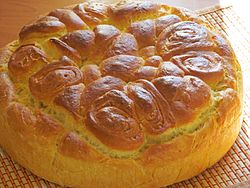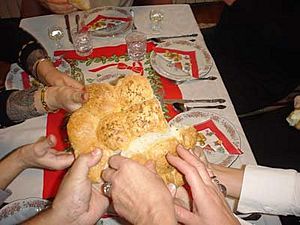Česnica facts for kids

Home-made Česnica
|
|
| Type | Bread |
|---|---|
| Place of origin | Serbia |
| Main ingredients | Wheat flour, water |
A česnica (pronounced ches-nee-tsa) is a special round loaf of bread. It's a very important part of the Christmas dinner in Serbian tradition. Its name comes from the Serbian word čest, which means "share."
People often put a coin inside the dough when they make it. Sometimes, other small items are added too. At the start of the Christmas dinner, the česnica is turned three times. Then, family members break it apart and share it. The person who finds the coin in their piece is believed to have good luck all year! In the past, people also used the česnica in old traditions to guess or influence how good the next year's crops would be.
Contents
Making the Česnica
The česnica is usually made from wheat flour. It's baked on Christmas Eve or early on Christmas morning. Often, the head of the family or the woman of the house bakes it.
Special Water and Rules
In some areas, the water for the dough is collected on Christmas Day before sunrise. It comes from a spring or a well, and people throw a handful of grain into it. This is called "strong water." People believe it has special, helpful powers.
Sometimes, there are other rules for making the bread:
- The flour must come from a full bag.
- The water for the dough might be collected from three different springs.
- The person making the česnica might bathe before starting.
In eastern and southern Serbia, after kneading the dough, the baker touches fruit trees, beehives, and farm animals with their dough-covered hands. This is done to help them be more productive.
Hidden Surprises
A coin is often placed inside the dough while it's being kneaded. Some families even use the same special coin every year!
In some regions, small figures carved from cornel wood are added. These figures might look like chickens, oxen, cows, pigs, or bees. Other areas might hide grains, beans, walnuts, bits of wool, or small twigs. In a place called Semberija, families put in a piece of wood from the first cut made when chopping the badnjak (a special Christmas Eve log). They do this "because of bees," as the tradition says.
Before baking, the top of the bread might be decorated. People might draw symbols like a Christogram (a Christian symbol), stars, circles, or even press keys or combs into the dough.
Vojvodina Variation
In Vojvodina, the česnica is a bit different. It's not a simple bread. Instead, it's a pastry made of layers of thin dough, like filo pastry. These layers are filled with chopped nuts and raisins, similar to baklava but drier. It usually has honey added. A coin is still hidden somewhere between the layers.
Christmas Dinner Traditions
Christmas dinner is often the most special meal of the year. It usually starts around noon or even earlier.
Starting the Meal
When the head of the household gives a signal, everyone at the table stands up. The head makes the Sign of the Cross and lights a candle. They then use incense to bless the family and say a prayer. After this, everyone kisses each other and says, "Peace of God, Christ Is Born."
Breaking the Bread
The head of the family and another family member hold the česnica. They rotate it three times counterclockwise. Then, they carefully break the česnica among everyone. Each person gets a piece of the bread, making sure no crumbs fall off.
Sharing and Luck
Up to three pieces of the česnica might be set aside:
- One piece for family members who are not there.
- One piece for any stranger who might join the dinner.
- One piece for the polaznik, who is the first visitor on Christmas Day (if they are not already there).
The rest of the česnica is eaten during the dinner. The family member who finds the coin in their piece is believed to have amazing luck in the coming year. The head of the family might even try to buy the coin from this lucky person! If other objects were hidden in the bread, finding one means you'll be extra successful in that part of the household's work. For example, finding a chicken figure might mean good luck with chickens.
Other Customs
In some areas, like the Bay of Kotor and Bukovica, the česnica is not broken and eaten at Christmas dinner. Instead, it's placed on the table or nearby with a candle stuck in it. The head of the household lights this candle at the start of dinner. In Bukovica, people might stick olive or bay laurel twigs around the candle.
The date when the česnica is eaten can vary. In the Bay of Kotor, it might be eaten up to twenty days after Christmas, on the Feast of Saint Sava. In some places, only half of the česnica is eaten at Christmas dinner. The other half is eaten a week later, on the Feast of St. Basil the Great.
Old Beliefs and Practices
In some regions, the česnica was used in old traditions to predict things.
Predicting Crops
In Bosnia, when the dough was shaped and ready for baking, people would cut notches into the top. They would place seeds of different crops into these notches. The more a notch rose during baking, the better that crop was expected to grow in the next year.
In Jadar, western Serbia, people would take embers (glowing pieces of wood) from the badnjak fire. The number of embers matched the types of grains and livestock the family had. Each type of crop or animal was linked to an ember on the česnica. The crop or animal whose ember glowed the longest was believed to be the most successful that year. Some people would also place a bowl of grain on the česnica to help ensure a lot of grain.
Ancient Traditions
In the 1800s in Herzegovina, two men would rotate the česnica between them. One would ask, "Am I sticking out [from behind the česnica]?" and the other would reply, "You are, a little." The first man would then say, "Now a little, and next year not even a little." This conversation was meant to bring a very good grain harvest in the coming year.
A similar practice was recorded long ago, in the 12th century, among West Slavs on the island of Rugia in the Baltic Sea. These people followed the cult of Svantovit, a god. They had a large temple dedicated to him. A writer named Saxo Grammaticus described a festival held there after the harvest. In one ritual, a large round loaf of bread, covered with honey and as tall as a man, was held in front of Svantovit's statue. The priest would go behind the loaf and ask if the people could see him. When they said yes, the priest would wish that next year they would not see him. This ritual also aimed to ensure a very rich grain harvest for the next year.
Images for kids
See also
 In Spanish: Česnica para niños
In Spanish: Česnica para niños




